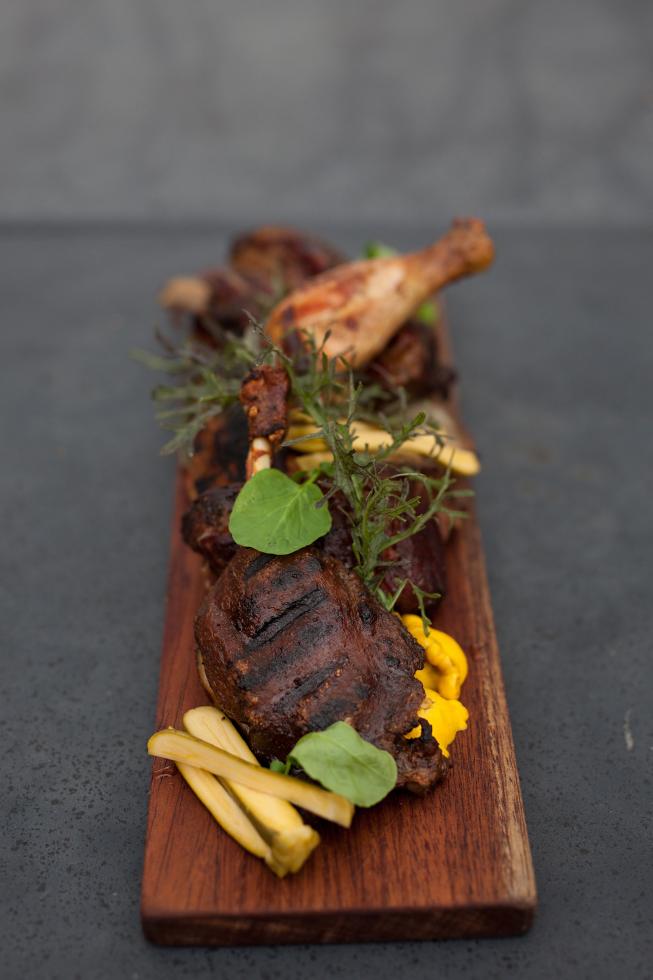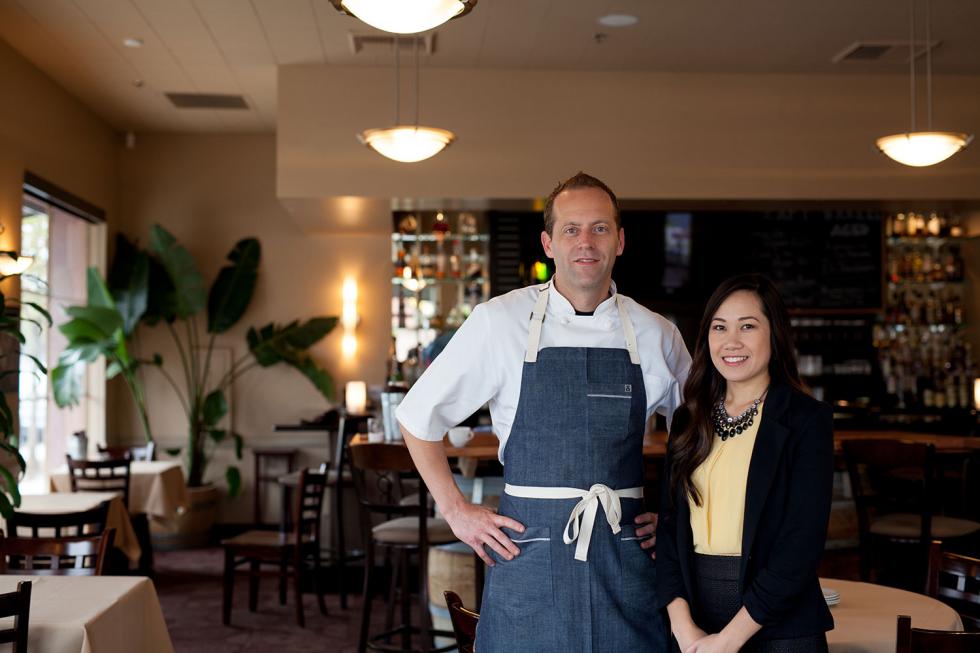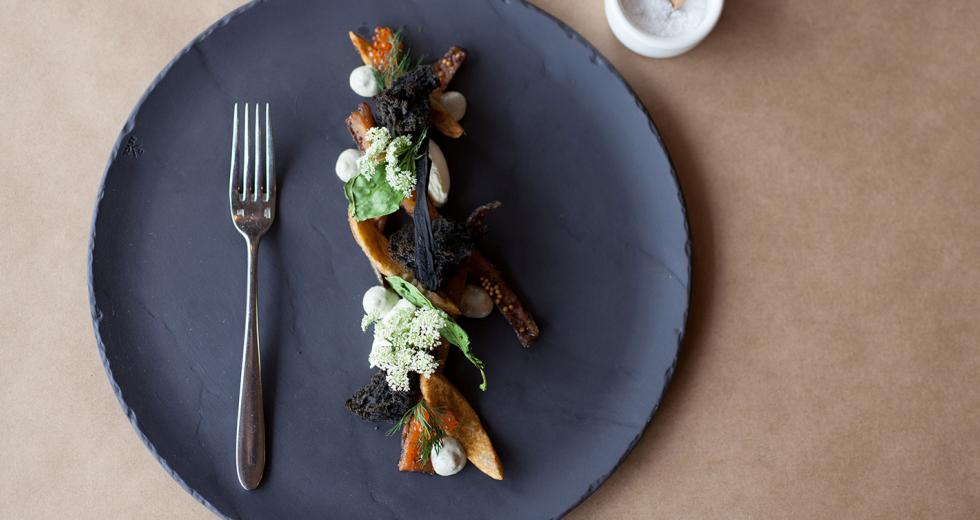At Cask & Barrel in north Sacramento, there are no entrees. The restaurant has a small kitchen staff and high-end food at low prices. Chef Gabriel Glasier and his pastry chef, business partner and fiancée, Kristel Flores, are bringing something different to a corner of Del Paso Boulevard that’s proved to be enigmatic, to say the least, for two decades.
Since 1995, the spot belonged to Enotria — the last incarnation of which closed in January 2014. It was a high-profile, pricey and generally- applauded attempt at Michelin-star caliber food. Enotria received rave reviews, and people did show up — on weekends. But it struggled midweek, which is the common bane of special-occasion restaurants. And neighbors, especially in nearby Woodlake, lost their easy-in local spot.
That was the first thing that Glasier and Flores tried to fix. The two have rejiggered everything but the look and the impressive wine cellar. Cask & Barrel calls itself a neighborhood spot serving “the cuisine of America,” as Glasier calls it — with an upgraded twist, a new love for whiskey and a specialty of slow-cooked meats. It also means a smaller dining room with smaller portions and smaller price tags.
“We want to be that neighborhood kind of restaurant,” said Flores, the businessperson in the operation. “We don’t want to be just a special-occasion place. We’re seeing people come in three times a week and sit at the bar. That’s our goal.”
To understand their approach, it’s important to understand Glasier’s larger view of the restaurant business. “The traditional business model for most restaurants is broken,” he says. “If you’re working 100 hours a week and not making any money, there’s something wrong.”
Cask & Barrel’s Smoke and Fire meat platter includes pork
shoulder, chicken drum and thigh, duck leg and short rib.

For a lot of restaurants, the problem starts with size. Many restaurateurs hope to pay high-priced rents with a bigger space. According to the National Restaurant Association, American restaurants average 140 seats and roughly 1.5 nightly table changeovers. That means many restaurants have to plan staffing — floor and kitchen — and food commitments for 200-plus customers nightly.
“But what happens on a slow day, one bad Friday, and you just get 40 people?” Glasier points out. “That’s a significant loss. One day of miscalculation, and you’re in catch-up mode. Repaying losses is the Easter Bunny. It doesn’t exist.”
“Make that mistake four times in a month and that could be it for you,” Flores adds.
Cask & Barrel has 40 seats, and has been averaging about 75 people a night. The duo says there is a list of advantages that come with a smaller size, starting with the obvious: A slow night causes less financial damage.
First, it means fewer people on the floor and in the kitchen. When they opened in February, Cask & Barrel ran with two people cooking. Now they’re up to three. All are experienced chefs who’ve worked with Glasier before.
Related: Making Way for a New Type of Dining
“We can pay them more than they’d get at a lot of other places,” Glasier says. “So they stay, we’re experienced, and we need fewer people in the kitchen.”
And they only use half of the building and one of the two kitchens, and run a catering and special events company called Chef and Baker in the back half, which also helps the bottom line.
Second, the smaller size addresses a huge factor in any restaurant’s success — managing food costs. Cask & Barrel projects within a tighter range, and that slow night doesn’t leave crates of food spoiling in the walk-in cooler.
The menu is either small bites or shared dishes — no traditional entrees — which Flores says makes their costs more predictable, gives prices the air of affordability while actually driving the average check up, and keeps customers satisfied with the variety those dollars provided.
Chef Gabriel Glasier and his pastry chef, business parter and
fiancée Kristel Flores say that their approach to keep things
small helps retain quality employees while also cutting food
costs.

Glasier also says an eat-local, farm-to-fork approach is simply good economics, because “when you use fresh ingredients, they last longer.”
He is one of the most praised — if under the popular radar — chefs in the region. Glasier served as executive chef at the highly-regarded Slocum House in Fair Oaks, Redbud Café in Cameron Park and Maranello in Fair Oaks. His food has the same sort of panache as Enotria’s chef, Pajo Bruich, but with an air of accessibility.
Take for instance, Glasier’s approach to his bacon mac & cheese: He uses modern techniques to engineer a Velveeta-like creaminess made entirely with real cheese, without food starch or processing. His re-imagined Hangtown Fry forgoes the traditional scrambled egg in favor of a chicken-fried egg that’s crispy but still has a runny yolk. And the featured meats are smoked seven hours, then cooked suis vide (vacuum-packed and slow-cooked in temperature-controlled water) for 72 hours.
“I do use modern cuisine techniques,” Glasier said, “but it’s to accent the food, not just for show. We get the exact textures we want.”
Plus, Glasier’s cooking style cuts down on leftovers. “We use every part of all sorts of ingredients,” Flores says. For example, instead of using expensive cream in a succotash, Glasier scrapes the cob of sweet corn for an intriguing creamy texture, another layer of flavor and a lower cost.
Longtime wine pro Matthew Lewis, the former sommelier at Enotria, says the new approach appears to fit the demands of the location.
“It’s a good strategy,” Lewis says. “[Glasier] sized down the number of customers he needs, which is more realistic there. By managing the staff size, and with his cooking, he offers a very good product at a very reasonable price. You get a $12 dish that’s jaw dropping and tastes like a $40 dish. So far, it’s penciling out. They’ve got it right – a little excitement and a little comfort.”
Drawing people is a constant battle for the area of Del Paso Boulevard around Arden Way. It’s maybe eight minutes from Sacramento’s downtown/midtown grid, but psychologically it’s miles away to many people.
“I’ve never understood that,” said David Veden, a member of the Del Paso Boulevard Partnership and owner of Associated Sound, a full-service audio/visual company in the district. “I think freeways become psychological barriers. We primarily do business with people around us and to the east as far as Watt, but not much from the grid.”
That might finally change. The middle stretch of Del Paso is starting to grow after years of stagnation, and what Veden calls neglect. There’s a craft brewery and pub coming, and there are plans for a splashy Italian restaurant and pizzeria to add to Cask & Barrel’s draw.
“Finally we have some real economic momentum,” Veden says. “When all that development around the arena and along Richards [Boulevard] gets going, that’s only going to help.”
Glasier and Flores also see improvement on the horizon. In the meantime, the rebranded corner allows the duo and the location itself to, in essence, start over with the neighborhood and local foodies — and to show that their idea of a great restaurant is different than what’s been there before.
“We think what we’re doing here is unique. We want it to stand out,” Glasier says. “This spot has had some struggles. We think we’ve got it right. This is a restaurant the neighborhood wants and we think the food is also worth coming to find.”



